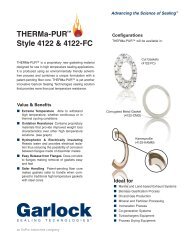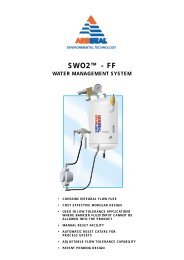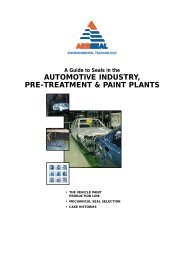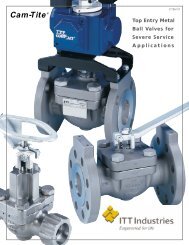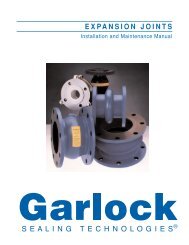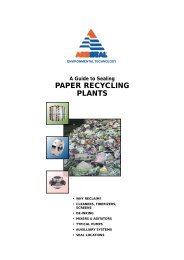A guide to sealing sulphuric acid plants - AR Thomson Group
A guide to sealing sulphuric acid plants - AR Thomson Group
A guide to sealing sulphuric acid plants - AR Thomson Group
You also want an ePaper? Increase the reach of your titles
YUMPU automatically turns print PDFs into web optimized ePapers that Google loves.
SSUULLPHUURRIICC ACCID IINNDDUUSSTTRRYY<br />
AESSEAL ®<br />
SULPHURIC ACID<br />
INDUSTRY<br />
L-UK/US-SULPH-02<br />
IN 4512 - 01/2002<br />
18<br />
Other Sulphuric Acid<br />
Applications<br />
I. Phosphoric Acid Production<br />
Concentrated Sulphuric Acid reacts with Phosphate Rock Slurry <strong>to</strong> form Phosphoric Acid<br />
and Gypsum Slurry. The Sulphuric Acid is often mixed with re-circulated, warm Phosphoric<br />
Acid in a pre-diluter <strong>to</strong> provide better control of the exothermic reaction and <strong>to</strong> reduce the<br />
corrosivity of the reac<strong>to</strong>r contents.<br />
For further details of Phosphoric Acid production see the AESSEAL ® Publication ‘A Guide<br />
<strong>to</strong> Sealing Phosphoric Acid Plants’.<br />
Concentrated Sulphuric Acid Pumps<br />
Option Minimum Required Best Available Option<br />
Seal Type External Single Seal Cartridge Double Seal<br />
Design CS + Stationary BI-Metal CDSA<br />
Metal Parts Alloy 276 or Alloy 20<br />
Inboard Faces GFT/Alumina Ceramic Silicon Carbide/Silicon Carbide<br />
Outboard Faces N/A Silicon Carbide/Carbon<br />
Elas<strong>to</strong>mer Vi<strong>to</strong>n ® Vi<strong>to</strong>n ®<br />
Gasket GFT GFT<br />
System API Plan 53, SSE10 P2<br />
Diluted Acid Pumps (Sulphuric, Recycled Phosphoric Acid)<br />
Seal Type Cartridge Double Seal<br />
Design BI-Metal CDSA<br />
Metal Parts Alloy 20 or 904L<br />
Inboard Faces Silicon Carbide/Silicon Carbide<br />
Outboard Faces Silicon Carbide/Carbon or Cr02/Carbon<br />
Elas<strong>to</strong>mer Vi<strong>to</strong>n ®<br />
Gasket GFT<br />
Drawing API Plan 53, SSE10 SW02<br />
J. Acid Pickling<br />
Sulphuric Acid at 5% <strong>to</strong> 15% concentration and temperatures up <strong>to</strong> 95°C (200°F) is used<br />
<strong>to</strong> remove oxide scale from forged, hot-rolled and heat-treated steel parts. The metal parts<br />
may be immersed in <strong>acid</strong>, or a spray process may be used. The reactions involved<br />
consume any dissolved oxygen, and hydrogen evolved from the action of <strong>acid</strong> upon the<br />
metal maintains the <strong>acid</strong> in a reducing condition. Inhibi<strong>to</strong>rs or accelera<strong>to</strong>rs may be added<br />
<strong>to</strong> control the process. Alloy 400 has traditionally been the material of construction for the<br />
plant, but Alloys 825 and 20 are now also used. Alloy 20 or Alloy 276 may be used for a<br />
mechanical seal.<br />
Copper, Copper Alloy and Brass parts are also pickled <strong>to</strong> remove oxide layers. The seal<br />
selections are as below. Hard faces are used due <strong>to</strong> the presence of solids in the <strong>acid</strong>,<br />
removed from the metal surfaces.<br />
Hydrochloric Acid and Mixed Acid solutions have replaced Sulphuric Acid in some<br />
processes. The seal selections below are not intended <strong>to</strong> cover these applications.<br />
© Copyright 2002 AESSEAL plc All Rights Reserved.



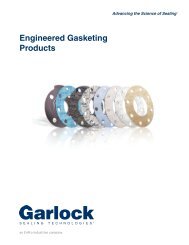
![VCS Flange Gasket [1.03 MB] - AR Thomson Group](https://img.yumpu.com/12044617/1/190x245/vcs-flange-gasket-103-mb-ar-thomson-group.jpg?quality=85)

![PGE Flange Gasket Product Brochure [1.04 MB] - AR Thomson Group](https://img.yumpu.com/12044595/1/190x245/pge-flange-gasket-product-brochure-104-mb-ar-thomson-group.jpg?quality=85)
